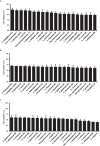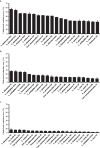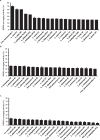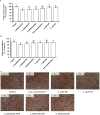Selection and Characterization of Probiotic Bacteria Exhibiting Antiadipogenic Potential in 3T3-L1 Preadipocytes
- PMID: 33961206
- PMCID: PMC8103433
- DOI: 10.1007/s12602-021-09793-5
Selection and Characterization of Probiotic Bacteria Exhibiting Antiadipogenic Potential in 3T3-L1 Preadipocytes
Abstract
Abnormal adipocyte growth, distinguished by an increase in cell numbers and cellular differentiation, is regarded as a major pathological characteristic of obesity. Thus, inhibition of adipogenic differentiation in adipocytes could prevent obesity. Recently, certain probiotic stains have been reported to regulate lipid metabolism in vitro and/or in vivo. In this backdrop, this study aimed to investigate basic probiotic properties and potential antiobesity characteristics of mouse 3T3-L1 preadipocytes. Six lactic acid bacteria (LAB) strains were prescreened for their cholesterol-lowering activity, antioxidant activity, and survival at low pH and in a solution containing bile salts. These six strains were investigated for antiadipogenic activity by employing 3T3-L1 mouse preadipocytes. 3T3-L1 cells were treated with selected strains during the differentiation process. Lactobacillus johnsonii 3121 and Lactobacillus rhamnosus 86 were found to be more capable of reducing triglyceride and lipid accumulation, as compared to control group, which are fully differentiated 3T3-L1 adipocytes. These strains also inhibited adipocyte differentiation by downregulating the adipogenic transcription factor in 3T3-L1 adipocytes. Taken together, these results indicate that L. johnsonni 3121 and L. rhamnosus 86 could potentially act as probiotic bacteria and prevent fat accumulation by regulating adipogenesis-related markers.
Keywords: 3T3-L1 preadipocytes; Adipogenesis; Lactic acid bacteria; Obesity; Probiotics.
© 2021. The Author(s), under exclusive licence to Springer Science+Business Media, LLC, part of Springer Nature.
Conflict of interest statement
The authors have no conflicts of interest to declare that are relevant to the content of this article.
Figures








Similar articles
-
Antiobesity Effect of Novel Probiotic Strains in a Mouse Model of High-Fat Diet-Induced Obesity.Probiotics Antimicrob Proteins. 2021 Aug;13(4):1054-1067. doi: 10.1007/s12602-021-09752-0. Epub 2021 Feb 10. Probiotics Antimicrob Proteins. 2021. PMID: 33569747
-
Pheophorbide A isolated from Gelidium amansii inhibits adipogenesis by regulating adipogenic transcription factors and AMPK in 3T3-L1 adipocytes.Nutr Res. 2022 Nov;107:187-194. doi: 10.1016/j.nutres.2022.10.001. Epub 2022 Oct 7. Nutr Res. 2022. PMID: 36323192
-
The inhibitory effects of Xiao-Gao-Jiang-Zhuo-containing serum on adipogenesis in 3T3-L1 preadipocytes.Biomed Pap Med Fac Univ Palacky Olomouc Czech Repub. 2024 Mar;168(1):25-34. doi: 10.5507/bp.2023.016. Epub 2023 Jun 1. Biomed Pap Med Fac Univ Palacky Olomouc Czech Repub. 2024. PMID: 37265261
-
Lactobacillus curvatus HY7601 and Lactobacillus plantarum KY1032 Cell Extracts Inhibit Adipogenesis in 3T3-L1 and HepG2 Cells.J Med Food. 2018 Sep;21(9):876-886. doi: 10.1089/jmf.2017.4157. Epub 2018 Aug 27. J Med Food. 2018. PMID: 30148699
-
Cellular models for the evaluation of the antiobesity effect of selected phytochemicals from food and herbs.J Food Drug Anal. 2017 Jan;25(1):100-110. doi: 10.1016/j.jfda.2016.10.018. Epub 2016 Dec 7. J Food Drug Anal. 2017. PMID: 28911527 Free PMC article. Review.
Cited by
-
Sargassum horneri extract fermented by Lactiplantibacillus pentosus SH803 mediates adipocyte metabolism in 3T3-L1 preadipocytes by regulating oxidative damage and inflammation.Sci Rep. 2024 Jul 2;14(1):15064. doi: 10.1038/s41598-024-65956-8. Sci Rep. 2024. PMID: 38956395 Free PMC article.
-
Screening for Lactic Acid Bacterial Strains as Probiotics Exhibiting Anti-inflammatory and Antioxidative Characteristic Via Immune Modulation in HaCaT Cell.Probiotics Antimicrob Proteins. 2023 Dec;15(6):1665-1680. doi: 10.1007/s12602-023-10048-8. Epub 2023 Feb 20. Probiotics Antimicrob Proteins. 2023. PMID: 36806154
-
Amelioration of Metabolic Syndrome by Co-Administration of Lactobacillus johnsonii CRL1231 and Wheat Bran in Mice via Gut Microbiota and Metabolites Modulation.Metabolites. 2025 Jul 9;15(7):466. doi: 10.3390/metabo15070466. Metabolites. 2025. PMID: 40710566 Free PMC article.
-
Anthocyanin-Containing Purple Sweet Potato (Ipomoea batatas L.) Synbiotic Yogurt Inhibited 3T3-L1 Adipogenesis by Suppressing White Adipocyte-Specific Genes.J Exp Pharmacol. 2023 May 22;15:217-230. doi: 10.2147/JEP.S405433. eCollection 2023. J Exp Pharmacol. 2023. PMID: 37252059 Free PMC article.
-
Transcriptome Analysis Reveals the Role of Sucrose in the Production of Latilactobacillus sakei L3 Exopolysaccharide.Int J Mol Sci. 2024 Jun 29;25(13):7185. doi: 10.3390/ijms25137185. Int J Mol Sci. 2024. PMID: 39000292 Free PMC article.
References
-
- Pellegrini M, Ponzo V, Rosato R, Scumaci E, Goitre I, Benso A, Belcastro S, Crespi C, De Michieli F, Ghigo E, Broglio F, Bo S. Changes in weight and nutritional habits in adults with obesity during the “lockdown” period caused by the COVID-19 virus emergency. Nutrients. 2020;12:7. doi: 10.3390/nu12072016. - DOI - PMC - PubMed
-
- Hill C, Guarner F, Reid G, Gibson GR, Merenstein DJ, Pot B, Morelli L, Canani RB, Flint HJ, Salminen S, Calder PC, Sanders ME. Expert consensus document. The International Scientific Association for Probiotics and Prebiotics consensus statement on the scope and appropriate use of the term probiotic. Nat Rev Gastroenterol Hepatol. 2014;11:506–514. doi: 10.1038/nrgastro.2014.66. - DOI - PubMed
Publication types
MeSH terms
LinkOut - more resources
Full Text Sources
Other Literature Sources
Miscellaneous

